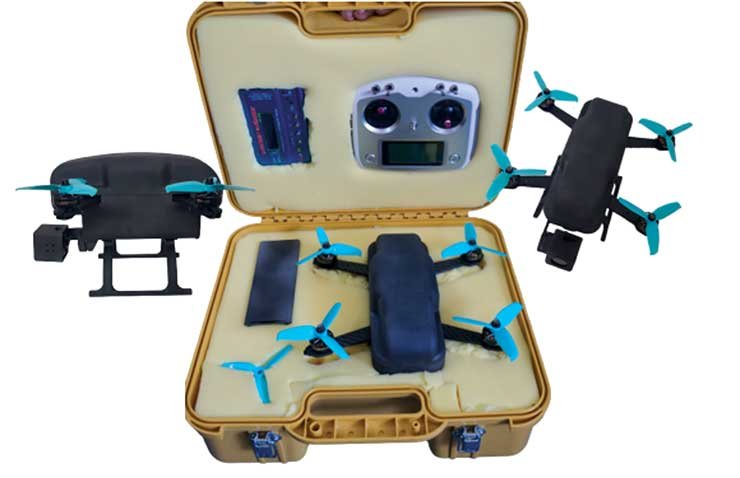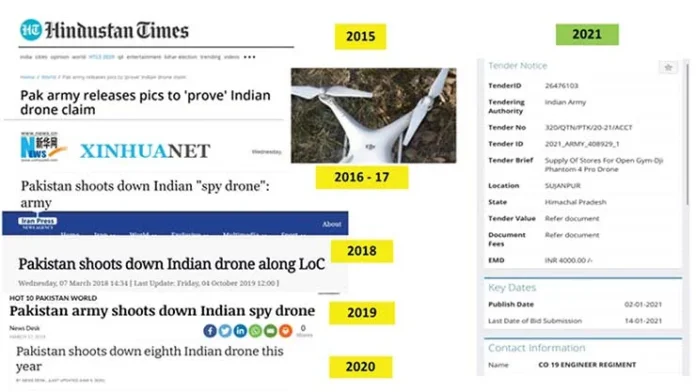The COTS (Commercial Off The Shelf) drones have been a major source of embarrassment for the Indian Army since 2015 with Pakistan claiming to shoot down Indian drones on multiple occasions while in fact, the drones in question were all Chinese manufactured DJI COTS drones.
This clearly points to the fact that Defence units have been procuring the Chinese DJI COTS drones and have been using them in preference to a similar class of products being offered by the Indian manufacturers. In fact, the huge population of these COTS drones over their Indian counterparts by 100 times indicates a clear preference for them at the Unit level. The Indian armed forces are not the only ones facing such problems. The ease of availability of the Chinese COTS drones coupled with restrictions on local manufacturing enabled these low-cost Chinese COTS drones to circumvent the stringent defence procurement system and penetrate right down to the frontline Unit level. In fact, with active support from the Chinese government by way of funding these COTS drones have turned out to be a significant incursion by a country inimical to Indian defence.
While the Chinese COTS drones unintentionally or otherwise have penetrated the Indian Defence ecosystem, their doing so has uncovered some very interesting facts: First, there is a strong demand for relatively-inexpensive COTS drones and secondly, the COTS products can be marketed to Defence units provided they deliver the outcomes users seek.
Blue sUAS
The Defence Innovation Unit (DIU), a Department of Defence (DOD) organisation that accelerates commercial technology for national defence has approved a list of five US-manufactured drone configurations to provide trusted, secure small Unmanned Aircraft Systems (sUAS) options to the US govt.
The list of products, referred to as ‘Blue sUAS’ come from five different manufacturers: Skydio, Parrot, Altavian, Teal Drones, and Vantage Robotics. The initiative is a follow-up of DIU’s Short Range Reconnaissance (SRR) programme, which worked with manufacturers to supply inexpensive, portable, and rapidly deployable small drones for the US troops.
India’s Army Design Bureau (ADB), the equivalent of the US DOD’s DIU is the ideal organisation that should create a similar ‘Blue sUAS’ list for Indian Defence Units to buy either on a published online price basis or on negotiated bulk discounts basis. The ADB should identify specific-use cases as may be required by end-users and get the manufacturers to customise their COTS drones for the specific application. These drones should be available for purchase on the government portals like GEM or a dedicated portal created by Indian Defence. Alternatively, the ADB could create a dedicated login-only portal for Defence units from which COTS products could be listed by interested Indian manufacturers on which Units can directly procure COTS products.

Fully Atmanirbhar
ZUPPA’s Ajeet Mini is one such fully Atmanirbhar COTS drone that can be immediately adapted to meet the various specific requirements of the Indian Defence units.
ZUPPA’s control of the technology from the system architecture stage to product manufacturing and delivery ensures that Ajeet Mini can be adapted to a wide range of applications like:
1. Training Drone without camera
2. Basic ISR : Single Day & Night Camera
3. Advance Camera Drone : with 4K Video Recording camera
4. Survey and Mapping Drone with RTK/PPK
5. Tethered Drone
6. Swarm Drones
7. Loitering munitions
The Importance of creating an approved list of COTS Drones that can be directly procured by Defense units under their local purchase budgets is critical to mitigate the huge National Security threat caused by the unaccounted Chinese DJI drones across critical Defense assets and installations.
The uncontrolled procurement of Chinese DJI Drones at the Unit level clearly points to a fact that an appropriately priced COTS product will be used if found suitable. The stringent & tedious capital purchase rules will and can be bypassed for reasonable priced COTS products. It has also demonstrated that Defence requirements need not necessarily be of MIL standards. Additionally, it has also demonstrated that when technology-centric COTS products solve the immediate problems for frontline units they will always find a way to procure them given their field requirements.
Conclusion
The 5th Generation Technologies are an electronic layer on top of existing equipment and resources, hence as we go forward in the adoption of these technologies, especially in areas such as unmanned systems, connected mobility and IoT, the clear lines between Defence and civilian use cases will blur significantly.
The adoption of COTS products and technologies in Defence will increase, hence it is extremely critical that the adoption of products be controlled by way of monitoring to ensure that a crucial factor like Data Security is effectively channelised.
–The author is Director of Sree Sai Aerotech Innovations Pvt Ltd.
–The writer established Zuppa Geo Navigation Technologies Pvt. Ltd., popularly known as ZUPPA in 2008. He is a recognised thought leader and author on the subject of Cyber Security of Drones. He has a deep understanding of India’s Drone Ecosystem both from a regulatory and manufacturing perspective and is a well-known name in the Aerospace and Defence Industry. The views expressed are of the writer and do not necessarily reflect that of Raksha Anirveda














